|
WATERLOO UNCOVERED 2019
by Major Charlie Foinette Coldstream Guards
and Mark Evans formerly Coldstream Guards
|
2019 was a vintage year for Waterloo Uncovered, marking several milestones. Chief amongst these was the sheer scale of last summer’s work, with the largest team we have yet assembled: some 106 veterans, volunteers, staff and students from eight different nations. 2019 was also the first time we lifted our sights to the wider battlefield, conducting excavations and surveys in three separate areas.
Our work at Hougoumont continued the work of previous years to expose and record the foundations and rubble of the buildings on the northern side of the chateau courtyard that were destroyed in the battle. This remains an interesting and exciting part of the farm, and once more, under the careful supervision of Phil Harding (from the Time Team television programme), work continued to investigate the surviving remains of the barn that once abutted the North gate, the scene of so much action in 1815. To his great delight, Guardsman Oliver Horncastle, a young Coldstreamer, found not only another Coldstream officer’s tunic button, but also from a Scots Guards’ button. More buttons surfaced over the next days, underlining the shared experience of Guardsmen then and now. These discoveries also led us to wonder whether tunics were discarded as men rushed to close the gates, or did wounded men seek the dubious shelter of the barn? Perhaps later digs will cast more light on what actually did happen on that day of battle. We haven’t yet discovered a Grenadier button to complete the set; perhaps their tailoring was better?!
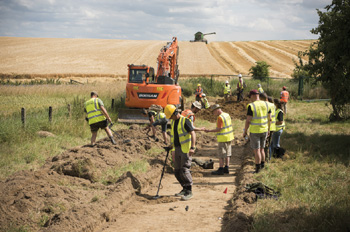 View of the strip survey in the orchard of Mont St Jean farm. To the south, being harvested, is the reverse slope of the ridge held by the Allies in 1815 View of the strip survey in the orchard of Mont St Jean farm. To the south, being harvested, is the reverse slope of the ridge held by the Allies in 1815
|
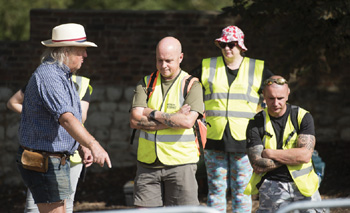 Phil Harding explaining the layout of the trench on which his team is working, just inside the North gate at Hougoumont
Phil Harding explaining the layout of the trench on which his team is working, just inside the North gate at Hougoumont |
Much else survives to excite the archaeologist. With contemporary plans and post-battle sketches showing varying scales and conflicting impressions of both the layout and construction of the lost buildings, it is satisfying to uncover solid evidence both for the dimensions and materials used. The barn that burned down during the battle seems to have been of similar construction to that which survives (the ‘great barn’), and rather larger. Interestingly, the thick layer of burnt and smashed slate, painstakingly excavated by Phil and his team, proves that the original building was roofed with slate rather than the red clay tiles used in the restoration of the surviving buildings. The effect created in what was then a very narrow gateway allows us to understand how it was defended successfully; it formed a narrow chokepoint that allowed the defenders to gain the upper hand against a desperate assault as the Light Companies sought to regain the farm. Even so, it is not hard to imagine the vicious nature of hand-to-hand fighting that marked such a pivotal action, and every burnt brick, shattered slate, and distorted musket ball tells a tale.
In a departure from previous years, we shifted our headquarters and the main focus of activity to a more central location. Drawing on the generous hospitality of the owner, Anthony Martin, we set up this year at Mont St Jean Farm, now a brewery producing an excellent range of ‘Waterloo’ beer (no way a factor in the decision!). As many readers will know, this farm was the site of the Allied field hospital in 1815 and received some 6,000 casualties, and we were interested to see if remnants of the battle survived around the site, and what we found exceeded expectation.
Following our established practice, we used a surveying technique that relied both on geophysical investigation using ground-penetrating radar and magnetometry to identify subsurface features, and a more general metal detector survey. The latter is especially useful on a battlefield of this nature, in which projectiles and the remnants of metal equipment give strong clues, but geophysical surveying allows us to identify man-made anomalies such as trenches, pits and areas of burning. Of course, in a working landscape that has been farmed since Roman times, one never quite knows what will be found until it appears. Sometimes, as in the area to the south of Hougoumont, the finds have been of great interest: brick kilns almost certainly relating to the original construction of the farm in the 17th century. But not everything is of interest, like the fine example of 20th century farm waste disposal, beautifully excavated but a little less exciting! Elsewhere on the site though, more welcome surprises were revealed.
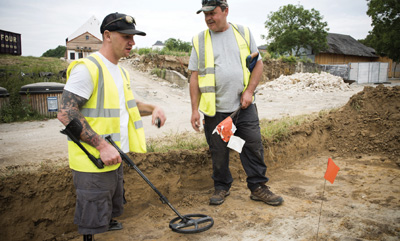
Shaun Stocker, a veteran of the Royal Welsh, who was injured in Afghanistan in 2010 while attached to the Coldstream Guards, undertaking a metal detector survey under the tutelage of Gary Craig, a volunteer and expert detectorist
|
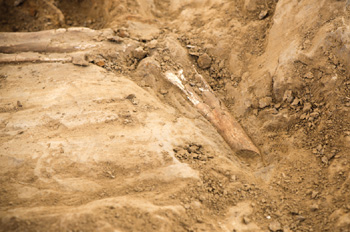 The remains of a human leg at Mont St Jean, showing an amputation cut at mid-thigh
The remains of a human leg at Mont St Jean, showing an amputation cut at mid-thigh
|
Our working supposition was that the hospital had been established in a safe position some way to the rear of the ridge, and that it had been affected little by the fighting. The metal detector survey in the orchard suggested otherwise. French and British musket balls, bearing the distinctive signs of firing and impacts were found very close to the farm, seeming to suggest a close contest nearby, presumably during the phase of the battle in which French cavalry ranged to the rear of the Allied lines amongst squares on the reverse slope. Still more intriguingly, we found evidence of artillery. That this occurred just as Charlie was explaining to a large group of cycling Coldstreamers led by Simon Vandeleur that ‘we haven’t found cannon balls and don’t really expect to’, only reinforces the danger of rash predictions! Until then we had presumed either that heavy projectiles had been picked up years ago or had gone so deep in the light soil that they would be beyond reach of detectors. Musket balls, far more numerous and susceptible to trampling, are a much easier prospect, but here we had a fine example of a French 6-pounder ball in the farm’s orchard. Given the range of the guns in use, it must have been fired close to the ridge, probably when the Allied centre was threatened after the fall of La Haye Sainte. It was a satisfying moment, but another was to follow a few days later: an unexploded 6-inch French howitzer shell, found nearly three feet deep where it had buried itself in the rain-soaked soil on the day of the battle. Unlike archaeologists working on First World War sites, we usually have little cause to trouble Belgian Explosive Ordnance Disposal teams, so it was very disappointing to the finds team to surrender that particular prize to those qualified to deal with it!
Given the function of the farm during the battle, there was always the possibility of finding human remains, although we had yet to find any at Hougoumont. With no obvious pits or historical evidence for mass graves in the area we were investigating, it was still something of a surprise when bones did appear. As a team was investigating a metal detector signal in the orchard, very close to the farm access track, the unmistakable signs of bone began to emerge. Very careful exposure established that they were human, and a specialist team from our local archaeology partner, Agence wallonne du Patrimoine, came to assist. In this soil, bones do not survive well, and tend to crumble very quickly if not treated with great care. Proper excavation is done with a ‘bone kit’ that includes dental instruments and fine brushes, and it is painstaking work. Nonetheless, our veterans were able to assist under expert supervision, and soon a fascinating picture emerged. The remains of three human legs and an arm were found, showing unmistakable marks of amputation and evidence of traumatic injury, including one with a musket ball still lodged in a smashed shin. Adding great interest was the fact that amputees were among the group working on this part of the site, and, as the bones were exposed we were visited by Mick Crumplin, a retired surgeon, who is perhaps the leading authority on the medical aspects of Waterloo, and has curated an extensive (and gruesome) collection of artefacts and records displayed at Mont St Jean. He explained in detail the surgical process used in 1815, and discussed the likely outcome for the unfortunate patients, while relating it to the experiences of today’s soldiers. It was a fascinating and sobering exposition that served to bring the distant past into stark relevance.
It would be a long fortnight if archaeology were the only activity, and a huge amount of effort from many willing volunteers was devoted to filling evenings with interesting communal activity. They are too many to list, but included history lectures, an art workshop, board game tournaments, films, and a very busy production line casting and painting model soldiers. Everyone was encouraged to try something new, from photography, to the poetry and creative writing workshop led by Nick Rendall, a retired Coldstreamer and contemporary of the authors. These activities don’t just pass time; they aim is to foster a community spirit that engages participants and bonds a team from widely varying backgrounds and experience. We are also participating in a clinical study to determine the benefits of this kind of interaction for veterans, especially those who have suffered injury (physical or mental) or who have experienced difficulty in adjusting to civilian life.
.jpg)
Piers Saunders, a British veteran, displaying the 6-pounder French cannon ball found at Mont St Jean
|
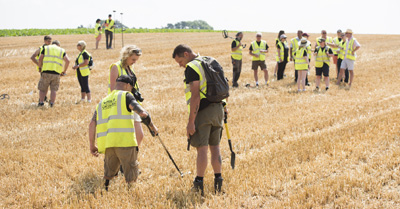 The field survey team preparing to conduct the initial metal detector survey of the freshly harvested reverse slope above Mont St Jean. Metal detector signals are carefully plotted using GPS survey equipment, and then investigated by hand digging to create a detailed plot. At Hougoumont, plotting the distribution of French and Allied musket balls (which are different sizes) in the ‘Killing Area’ gave us a clear impression of the location of troops and the intensity of fighting
The field survey team preparing to conduct the initial metal detector survey of the freshly harvested reverse slope above Mont St Jean. Metal detector signals are carefully plotted using GPS survey equipment, and then investigated by hand digging to create a detailed plot. At Hougoumont, plotting the distribution of French and Allied musket balls (which are different sizes) in the ‘Killing Area’ gave us a clear impression of the location of troops and the intensity of fighting
|
Finally we must, once again, record our heartfelt appreciation for the enormous support that Waterloo Uncovered has received from supporters, both as individuals and from organisations that include our own regiment and the Household Division. Many of those supporters who will read this will hopefully feel that we have justified your generosity.
We were delighted to learn recently that Waterloo Uncovered has been given a ‘Points of Light’ Award from the Prime Minister, a daily award for voluntary organisations that will hopefully recognise our partners and bolster fundraising. Our award, which marks the date 3rd February 2020, may be found at pointsoflight.gov.uk
The project is going from strength to strength, and amongst last summer’s visitors were the Major General and DSACEUR. With their interest and encouragement, we aim to ‘continue the motion’ of cooperation between the Allies of 1815 and 2020, albeit through the medium of trowels rather than muskets. We’ll be back in 2020, and would be delighted to see visitors if you happen to be passing through the battlefield from 6th-17th July! Further information is on our website, waterloouncovered.com
|
|

 View of the strip survey in the orchard of Mont St Jean farm. To the south, being harvested, is the reverse slope of the ridge held by the Allies in 1815
View of the strip survey in the orchard of Mont St Jean farm. To the south, being harvested, is the reverse slope of the ridge held by the Allies in 1815


.jpg)
